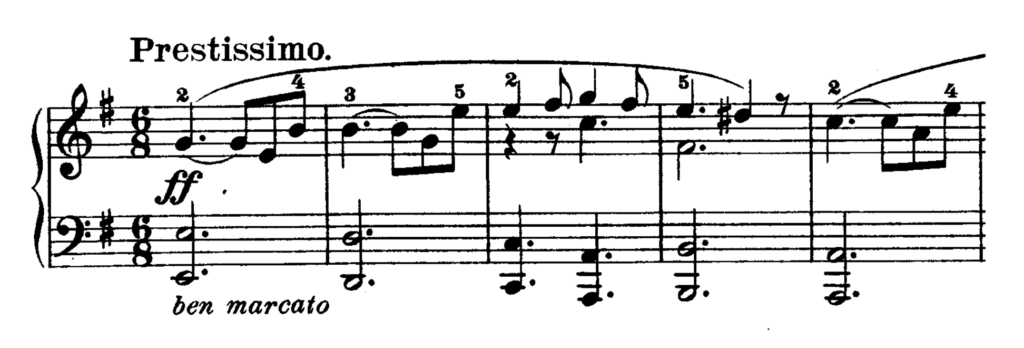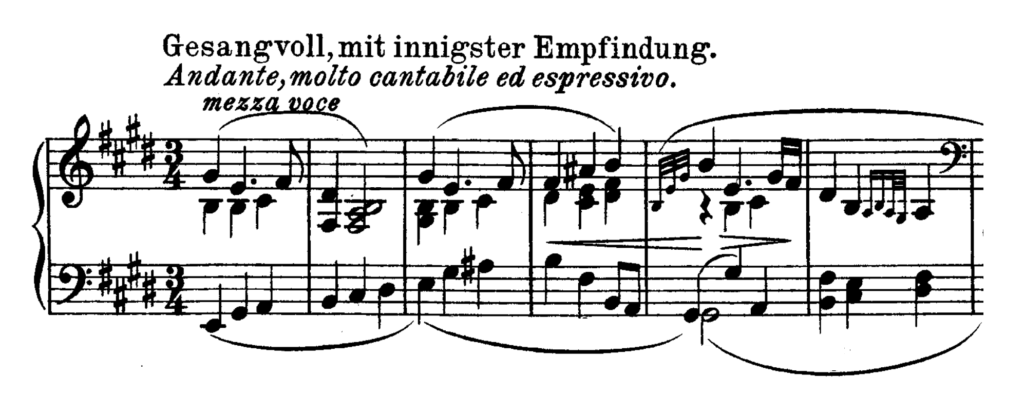Analysis
Contents
For the benefit of all pianists learning this work, we present to you a concise and easy to use analysis of Beethoven’s Piano Sonata No.30 in E major.
First Movement (Vivace Ma Non Troppo)
Form: Rondo Form. E Major.
FIRST PART;
Bars 1-9: First Subject in E major (tonic). The first subject begins with a four-bar phrase ending in tonic key, Bars 1-5, followed by another phrase of the same length, ending in the key of B major, Bars 5-9. After this it appears as if another phrase were about to commence, but it gets no further than half a bar’s length, Bar 9, before it is interrupted by an episode.
Bars 10-16: Episode. This episode, which begins with a discord (inversion of dominant minor ninth) is, after the first two bars, in the form of a cadenza; it commences in the key of C sharp minor and ends in B minor.
Bars 17-59: First Subject (varied), beginning in B major. The first subject is only represented rhythmically and by development (the treble, Bars 1-2, is in the bass in a different key (B major), Bars 17-18). At Bar 23 a new melody is introduced upon the first subject-figure, commencing in G sharp minor. An inverted dominant pedal point, Bars 44-50, leads to a repetition of the first subject in a modified form upon a scale passage in the bass, altered so as the end in tonic key. The perfect cadence, however, is interrupted (as at Bars 9-10) by an episode (Bar 60).
SECOND PART:
Bars 60-67: Episode. This Episode, although it resembles that in Part I, inasmuch as it is formed upon the same figure, is considerably varied both harmonically and melodically.
THIRD PART:
Bars 68-89: First Subject (varied), in original key. The first subject re-appears in the tonic key, varied. At Bars 81-84 the melody, which appeared at Bar 23, is referred to.
Bars 89-End: Coda. The Coda is constructed upon tonic pedal point and is suggestive of the first subject.
Second Movement (Prestissimo)
Form: Sonata Form. E Minor.
EXPOSITION:
Bars 1-24: First Subject in E minor (tonic). The first subject may be divided into two parts, both beginning and ending in tonic key. First Part, Bars 1-8; Second Part, Bars 9-16. The second part, which is constructed upon a dominant pedal point, is repeated with slight additions, Bars 17-24.
Bars 25-42: Connecting Episode. The connecting episode leads off with a four-bar phrase (in octaves) in tonic key, Bars 25-28, imitated and harmonised, Bars 29-32, leading to pedal point on dominant of B minor, which is suggestive of the second part of the first subject, preparatory to the entry of the second subject, Bar 42.
Bars 42-66: Second Subject in B minor. The second subject for six bars is sequential in character, Bars 42-48. At Ba 49 it modulates to C major, and continues in that key until Bar 55, where by means of the chord of the diminished seventh on E sharp (F natural) it proceeds back to B minor, which key is well established by the four bars which follow, Bars 57-60, treated in double counterpoint, Bars 61-64. The second subject ends in B minor, Bar 66.
DEVELOPMENT:
Bars 66-104: The development commences with a reference to the first subject, the bass of the first four bars being adapted from that at Bars 59-60 forming a subject which is repeated at various intervals upon pedal point, Bars 70-78, resolving itself at Bar 79 into C major, in which key, at Bar 83, an episode is introduced, which modulates to E minor. The development ends with the dominant chord of B minor.
RECAPITULATION:
Bars 105-119: First Subject in original key. The first part of the first subject re-appears in double counterpoint, Bars 112-118, the former bass slightly altered, appearing in the treble. The second part of the first subject is omitted.
Bars 119-143: Connecting Episode. The connecting episode is constructed of the same material as before, the beginning being transposed into C major (preceded by a modulation into that key, Bars 119-120). It ends in tonic key.
Bars 143-167: Second Subject in E minor (tonic). The second subject re-appears with the necessary transpositions, so as to end in the tonic key, instead of in the dominant minor; otherwise it is only slightly altered.
Bars 168-End: Coda. The Coda mainly consists of a perfect cadence followed by a passage in contrary motion, the bass of which, beginning at Bar 170, is taken from that at Bars 158-161.
Third Movement (Andante Molto Cantabile Ed Espressivo)
Form: Air With Variations. E Major.
AIR:
Bars 1-16: The “Air” is divided into two parts, both repeated; the first part ending on the dominant, Bar 8, the second part with full close on tonic, Bar 16.
FIRST VARIATION:
Bars 1-19: The interest of the first variation is principally confined to the melody.
SECOND VARIATION:
Bars 1-32: The second variation is constructed upon a fanciful figure. At Bar 9-12 an episode is introduced which appears again at Bars 25-28.
THIRD VARIATION:
Bars 1-32: The time is changes in the third variation from 3/4 to 2/4. This variation contains a great deal of double counterpoint. Bars 1-4 are inverted with slight alterations at Bar 5-8, and in the same way Bars 9-12 at 13-16, and Bars 17-24 at Bars 25-32.
FOURTH VARIATION:
Bars 1-2: The fourth variation (the time of which changes to 9/8) is in striking contrast to the preceding variation. It is constructed upon the figure in Bar 1, excepting at Bars 12-14, which are of a different character.
FIFTH VARIATION:
Bars 1-40: The fifth variation (in common time) is in the fugal style. A subject based upon the original air is answered at the second above for two bars in canon with an independent bass. This subject is treated in various ways, the fugal character being maintained throughout.
SIXTH VARIATION:
Bars 1-36: The sixth variation beginning in the original 3/4 time is a most elaborate one. The beginning of it is like a series of variations upon the first two bars of the air, which are given in almost their former simplicity, Bars 1-2. At Bars 2-3 the variation is just manifest; two parts in crotchets (quarter notes) being changed to quavers (eighth notes). At Bar 5 the time is changed to 9/8 and the accompaniment to triplets of quavers, which alter to semiquavers (sixteenth notes), Bar 6, and to demisemiquavers (thirty-second notes) in 3/4 time, Bar 8. At Bar 12 quite a new form of variation is introduced, which continues for four bars, followed by a brilliant episode formed upon dominant pedal point, which is inverted at Bar 25, where the second part of the air appears (varied) in the treble.
Bars 36-End: Original Air. At Bars 36 the “Air” is given in its original form, without repeats.









